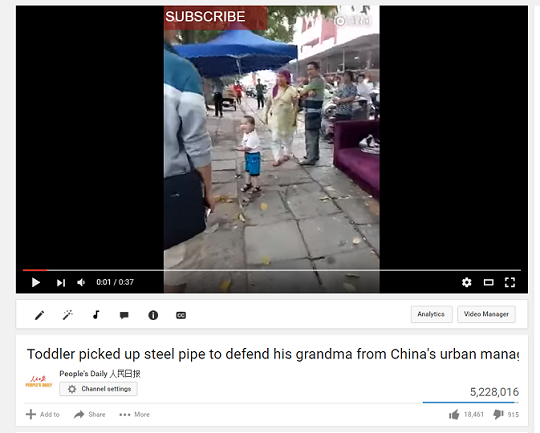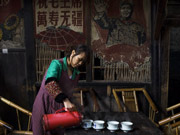

Chinese President Xi Jinping attends the 24th APEC Economic Leaders' Meeting in Lima, Peru, Nov. 20, 2016. (Xinhua/Ju Peng)
SANTIAGO, Nov. 23 (Xinhua) -- Chinese President Xi Jinping left the Chilean capital of Santiago Wednesday morning after wrapping up his state visits to Ecuador, Peru and Chile, and attendance at the 24th Asia-Pacific Economic Cooperation (APEC) Economic Leaders' Meeting in Lima, Peru.
It was the third and fourth time for Xi, respectively, to visit Latin America and attend the APEC meeting since his taking office in 2013, through which analysts see a bigger role of China in regional and global affairs.
COMPREHENSIVE STRATEGIC PARTNERSHIPS
During his week-long trip, President Xi held talks with his Ecuadorian counterpart Rafael Correa and Chilean counterpart Michelle Bachelet, and they decided to lift China's relationship with Ecuador and Chile respectively to a comprehensive strategic partnership.
Xi also met his Peruvian counterpart Pedro Pablo Kuczynski and they agreed to further enhance the comprehensive strategic partnership of the two countries, which was established in 2013.
Although there is no clear definition of the "comprehensive strategic partnership," it is usually regarded the highest level in China's diplomatic intimacy with other countries.
Political willingness and the need for economic cooperation are often two pillars, among others, of the partnership, said Zhang Lili, a professor with China Foreign Affairs University.
Ecuador is an important country in Latin America, said Xi, on the first visit by a Chinese president to Ecuador over the past 36 years since the establishment of diplomatic relations.
Echoing Xi, Ecuadorian president Rafael Correa believed that China, as the world's second-largest economy with a high speed of growth, can play a very important role in bolstering Ecuador's development, especially against the backdrop of low oil prices.
Since President Correa came into power in 2007, Ecuador has focused on deepening ties with China. The Ecuadorian president's first official trip to Beijing took place in the same year.
In 2015, on Correa's second China visit, he and Xi agreed to elevate the bilateral ties to the level of strategic partnership, only one year before the upgrade to the latest level.
Economic cooperation grew fast as well. Despite the long distance, China has become Ecuador's third largest trading partner, with two-way trade reaching 4.1 billion U.S. dollars in 2015, quadrupling in just 10 years.
And Ecuador is now a major destination for Chinese investment and financing in Latin America. Chinese investment and financing in Ecuador has exceeded 10 billion dollars, supporting hundreds of projects including major infrastructure projects such as the Coca Codo Sinclair hydropower plant, seven other hydropower plants and a dozen of highways.
On Thursday, President Correa himself went to the Quito airport to welcome the Chinese president. On Friday, Correa saw Xi off at the airport.
Situations may vary in Peru and Chile, but the willingness for cooperation is alike.
Peruvian President Kuczynski visited China in September this year, only six weeks after his inauguration, and two months before Xi's visit to Peru.
During Xi's visit to Chile, China and the Latin American country decided to initiate negotiations on upgrading their free trade agreement (FTA) as soon as possible.
The two countries signed their FTA in 2005. Bilateral trade volume has grown four-fold since the FTA went into effect in 2006. China is now Chile's largest trading partner, its largest export destination and the largest buyer of its copper products.
On Tuesday, Chilean President Bachelet also expressed her country's intention of joining the China-initiated Asian Infrastructure Investment Bank.
"The elevation of the bilateral relationships shows the growing willingness for bilateral cooperation between China and these countries,"said Wu Hongying, director of the Latin America office of the China Institute of Contemporary International Relations.
CHINA-LATAM COMMUNITY OF COMMON DESTINY
While addressing the Peruvian Congress on Monday, Xi called on China and Latin American countries to strengthen dialogue on global issues and boost cooperation on domestic development, in a bid to better build their community of common destiny on a new starting point in history.
The natural sense of recognition to each other and the shared sense of mission have made us look at our relationship from a strategic and long-term perspective, Xi said, noting that China and Latin American countries can understand and support each other on core interests and major concerns.
Xi proposed that China and Latin America and the Caribbean hold high the banner of peaceful development and cooperation, seek synergy between their development strategies, speed up and upgrade practical cooperation and bring benefits to both peoples.
Xi noted that China will firmly support Latin American countries in seeking development paths suited to their national conditions, gaining greater strength and prosperity through unity, and playing a bigger role in regional and international affairs.
The Chinese president also announced that in the next three years, China will increase the number of training opportunities of various kinds for Latin America and the Caribbean to 10,000.
On Tuesday, Xi, accompanied by his Chilean counterpart Bachelet, attended a summit of Chinese and Latin American media executives in Santiago, at which he urged Chinese and Latin American media agencies to jointly expand their influence and introduce to the world a more realistic image of China and Latin America.
"It was the third time that President Xi has set foot in Latin America since 2013, which shows how much attention he pays to the ties between China and Latin America," Wu said.
From May 31 to June 6, 2013, Xi made state visits to Trinidad and Tobago, Costa Rica and Mexico.
In July 2014, Xi paid state visits to Brazil, Argentina, Venezuela and Cuba. Moreover, a forum between China and Latin America was established to steer the overall cooperation between China and the region.
The first ministerial meeting of the China-CELAC (Community of Latin American and Caribbean States) Forum was then held in Beijing in January 2015, marking the start of a new era that features all-round cooperation between the two sides.
In 2015, the trade volume between China and Latin America reached 236.5 billion dollars, up more than 20-fold during the past decade, according to Chinese official statistics.
In 2016, China-Latin America relations have moved forward with the setup of new platforms such as the China-Latin America cultural exchange year and the forum of China-Latin America cooperation between local governments.
Currently, China is the second-largest trade partner and third-largest investment source country of Latin America, while Latin America is China's seventh-largest trade partner, and important overseas investment destination.
ADVOCACY FOR FREE TRADE AREA OF THE ASIA-PACIFIC
At the APEC CEO summit in Lima, President Xi renewed his call for pushing forward the building of the Free Trade Area of the Asia-Pacific (FTAAP), saying it is a strategic initiative critical for the long-term prosperity of the Asia-Pacific.
"We should firmly pursue the FTAAP as an institutional mechanism for ensuring an open economy in the Asia-Pacific," he told global business leaders, emphasizing openness is the lifeblood of the Asia-Pacific economy.
The FTAAP process was launched at the 2014 APEC Economic Leaders' Meeting in Beijing with the endorsement of a roadmap. A "collective strategic study" was subsequently conducted, as agreed by the APEC members, and the result should be reported to the economic leaders by the end of 2016.
Once established, the FTAAP, the largest free trade area in the world,can unleash much greater economic vigor than other regional trade arrangements and add an estimated 2.4 trillion U.S. dollars of output to the global economy.
"We have an obligation to continue the core agenda. Perhaps the first issue is the adoption of the collective strategic study, which was required by the Beijing Roadmap," Raul Salazar, APEC affairs director at the Peruvian Foreign Ministry, told Xinhua in Lima.
Economic globalization, open economy, regional inter-connectivity, and reform and innovation were key words of Xi's speech, which was encouraging under the current international situation.
As protectionism and isolationism are on the rise in Europe and North America, China's leadership grows stronger, providing commercial openness, cooperation and multilateralism, the leading Chilean newspaper El Mercurio said in its editorial release on Tuesday.
With the future of the U.S.-backed Trans-Pacific Partnership (TPP) dims under U.S. President-elect Donald Trump, the alternative Regional Comprehensive Economic Partnership (RCEP) occupied the center stage at the APEC meeting in Peru.
The 16-member RCEP, composed of the 10 member of the Association of Southeast Asian Nations plus China, Japan, South Korea, Australia, New Zealand and India, missed its negotiation deadline last year, but with the uncertainty of TPP, RCEP has regained attention at the APEC Economic Leaders' Meeting.
Analysts believe that the RCEP will become the main path toward the final realization of a free trade area of the Asia-Pacific.
"We must energize trade and investment to drive growth, make free trade arrangements more open and inclusive and uphold the multilateral trading regime," said the Chinese president.
Xi's proposal was echoed by other APEC leaders, as they reaffirmed their commitment that the FTAAP should be built upon ongoing regional undertakings, and through possible pathways including the Trans-Pacific Partnership and the Regional Comprehensive Economic Partnership.
"We reiterate our commitment to the eventual realization of the Free Trade Area of the Asia-Pacific as a major instrument to further deepen APEC's regional economic integration agenda," reads the declaration after the Economic Leaders' Meeting.
"That China's push for FTAAP has won positive response from APEC members shows China's special role in the region, which will also help increase the region's part in global recovery," said Wu, the Chinese scholar.
 |

 Who Will Fit The Chinese Roles In Game Of Thrones?
Who Will Fit The Chinese Roles In Game Of Thrones? China's Hubei Shennongjia added to World Heritage List
China's Hubei Shennongjia added to World Heritage List Cute Dog At Fruit Stand Becomes Latest Internet Sensation
Cute Dog At Fruit Stand Becomes Latest Internet Sensation Top 10 livable Chinese cities
Top 10 livable Chinese cities The last primitive tribe in China
The last primitive tribe in China China's first intelligent security robot debuts in Chongqing
China's first intelligent security robot debuts in Chongqing A Total of 3,552 Subscribers Vanish In Two Days; YouTube Closes All Doors to Users’ Inquiries
A Total of 3,552 Subscribers Vanish In Two Days; YouTube Closes All Doors to Users’ Inquiries Out of this world! Futuristic UFO-shaped yacht has its own garden and a stunning underwater viewing deck
Out of this world! Futuristic UFO-shaped yacht has its own garden and a stunning underwater viewing deck An old tea house in Chengdu
An old tea house in Chengdu Furious Customer Crushes All the Buns from Vendor Just Because He Was Given the Wrong Flavor
Furious Customer Crushes All the Buns from Vendor Just Because He Was Given the Wrong Flavor